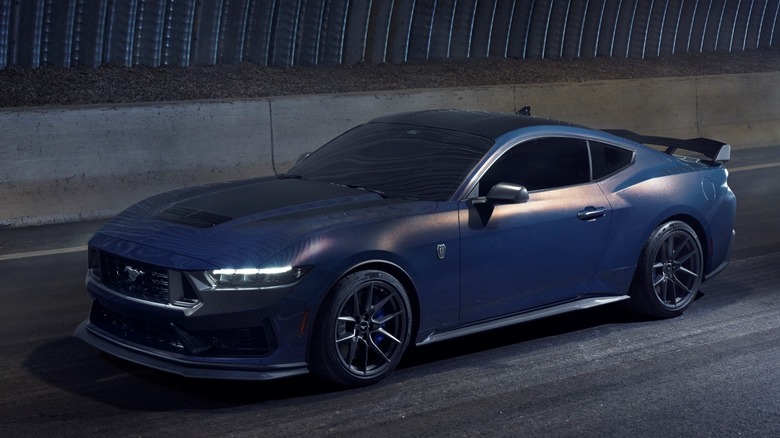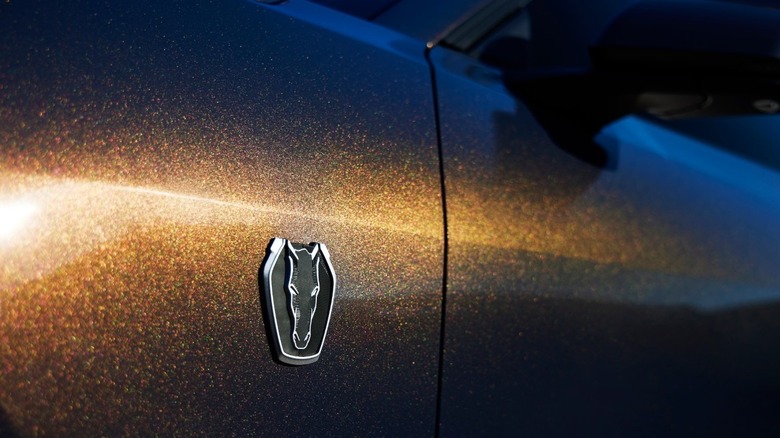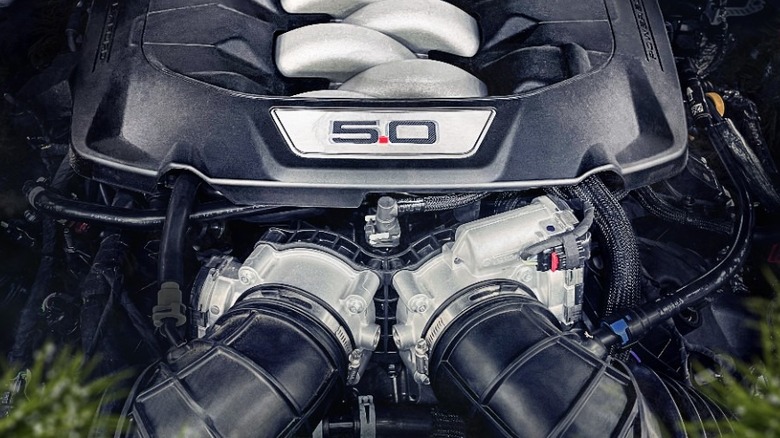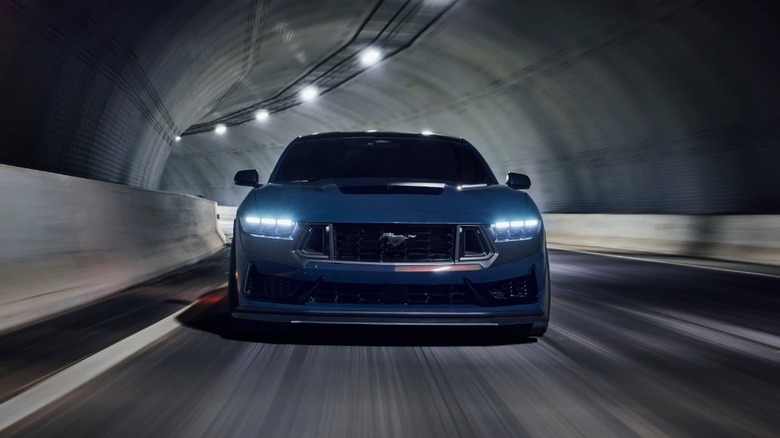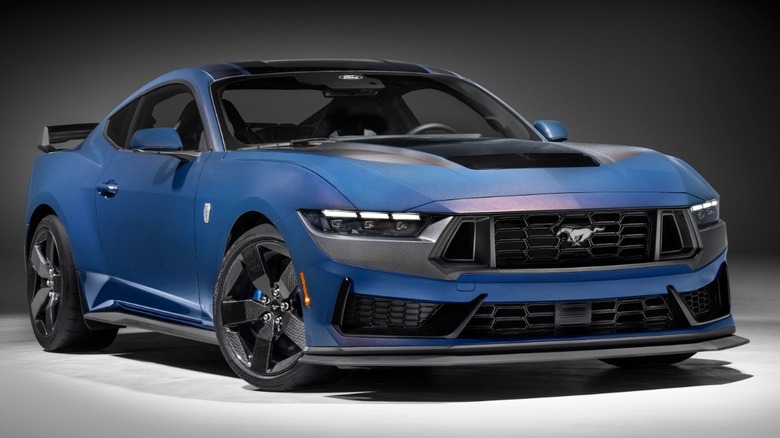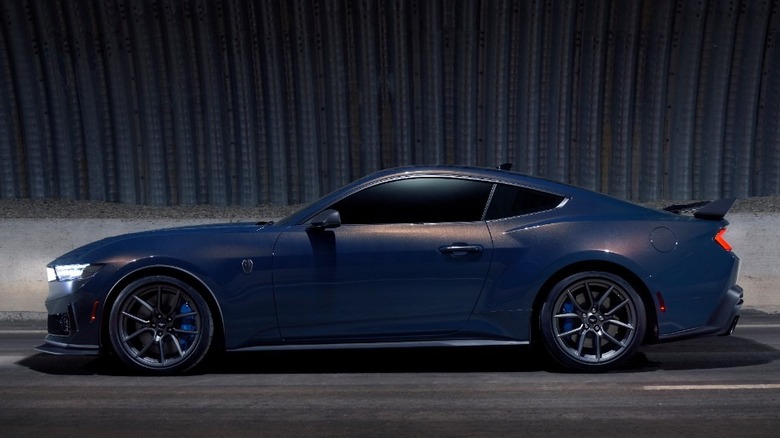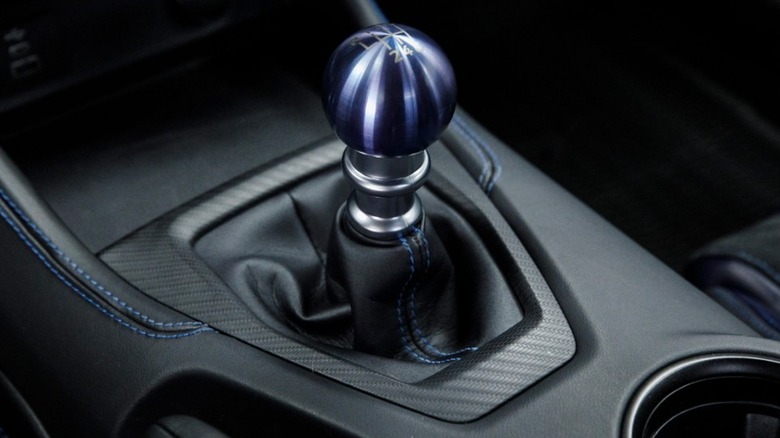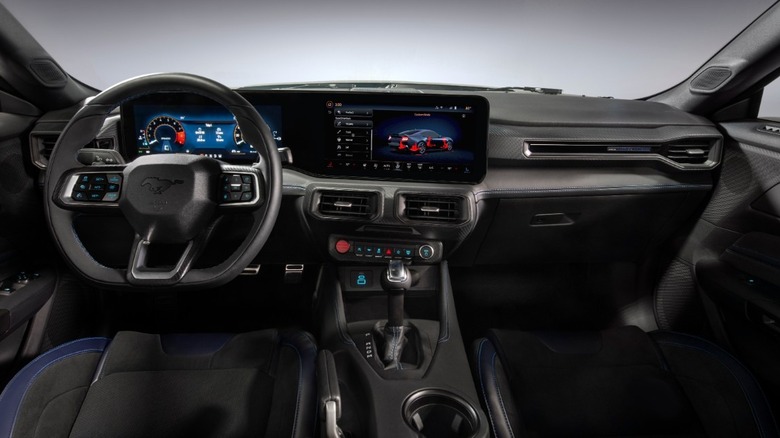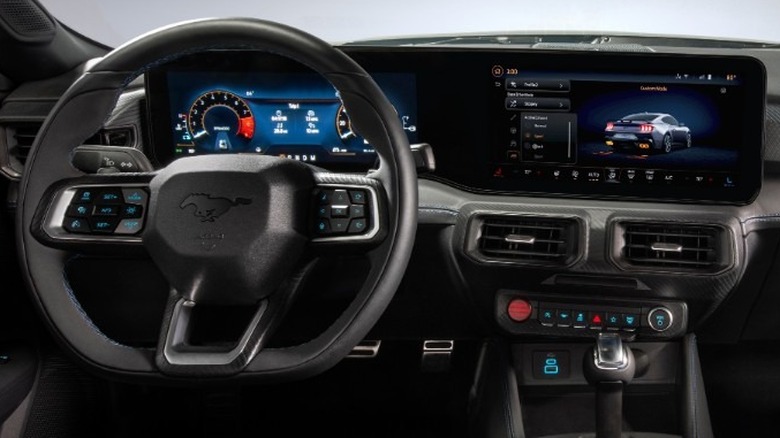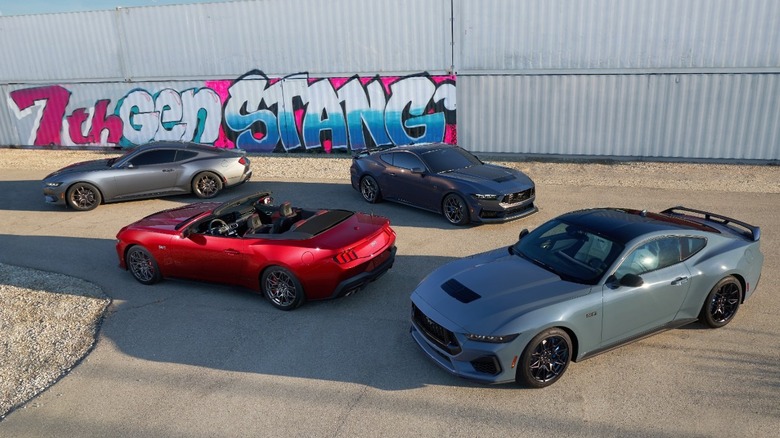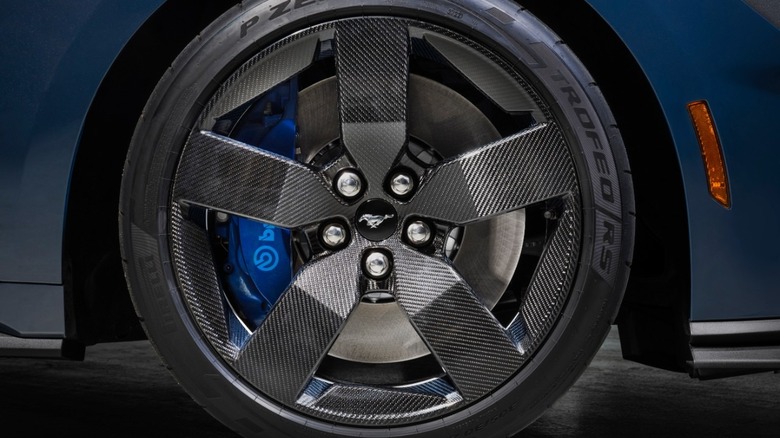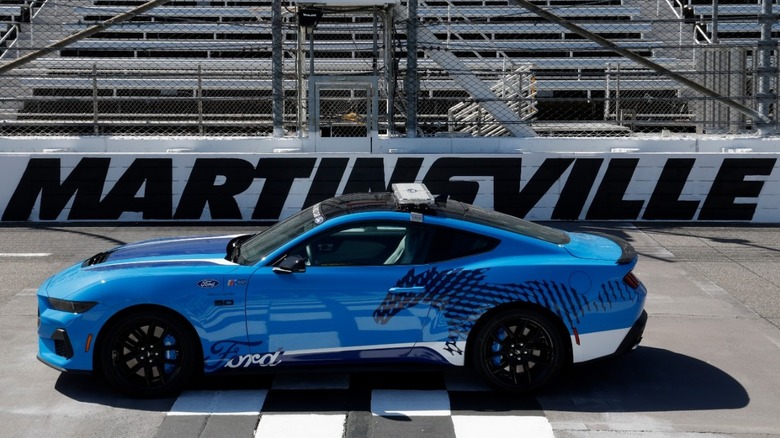2024 Ford Mustang Dark Horse: Everything We Know So Far
Since its birth in 1965, the Ford Mustang has been an iconic entry into the American automaker's lineup. While it's had its ups and downs over its nearly 60 years in production, the Mustang has always had a singular air about them, and after Carroll Shelby convinced Ford to let him turn the "secretary's car," as he once called it, into something beefier and more impressive on race day, Mustangs have pursued greatness, both on the track and in the hearts of collectors. That pursuit has led to a number of one-offs and limited production runs, some designed with power in mind, and others just unique versions of the classic pony car.
With the recent launch of the Mustang Mach-E, Ford introduced a new version of a classic, a fully electric crossover that bears the Mustang name. In keeping with that theme, Ford introduced the Dark Horse – a performance-minded line of seventh-generation Mustangs that are more focused on power, speed, and taking Ford back to being "First On Race Day." Announced alongside track variants and upcoming participation in several racing series, Ford looks to regain prominence in racing worldwide with the Dark Horse line. Here's what we know so far about the newest version of the Ford Mustang, the Dark Horse.
The Dark Horse is the product of three years of work and research
Ford tells us that their engineers and designers have spent over three years dreaming up the Dark Horse. It's the first new performance name for a Mustang since the 2001 Mustang Bullitt, putting great expectations upon the newest pony in Ford's stable. Ford is looking to the Dark Horse to bring the focus back on the racing success that they were once known for. As Ford CEO Jim Farley said in a press release, "We surprised everyone, and we're going to surprise them again..."
Part of a new performance name includes custom badging. The Dark Horse has its custom label in a forward-facing horse, one that is meant to convey a Mustang that's "...aggressive, a bit sinister and it's coming from the shadows head-on to win," according to Ford Design's global director Joel Piakowski in the aforementioned Ford press document. It's the first time Ford has ever used a forward-facing horse, and the new badge rests on the Dark Horse's fenders, trunk, and door sills. The classic side-view Mustang badge, represented in a darker, anodized form, remains on the front of the vehicle.
The engine is the most powerful NA V-8 Ford has ever made
Put simply, the modified fourth-generation Coyote 5.0 liter V8 is the most powerful engine Ford has ever put in a Mustang. Forged piston connecting rods are used, the same kind introduced in the Shelby GT500 to handle higher pressures in the cylinders and hold up to higher piston speeds. A uniquely balanced crankshaft and strengthened camshafts are also incorporated.
The Coyote V8 is also in the Mustang GT; however, this particular version was engineered specifically for the Dark Horse and is capable of delivering 500 horsepower and 418 ft.-lbs. of torque. The GT's engine output is slightly lesser at 486 horses. It is a benchmark for Ford as they return their focus to racing development, as they say, it's the most powerful naturally-aspirated V-8 engine they have ever built. For comparison's sake, the 2023 Dodge Challenger SRT Demon 170's power plant delivers 1,025 horsepower from a 6.2 liter supercharged V-8. Notably, and maybe thankfully for Ford, Dodge has announced that they will no longer produce gas-powered muscle cars after 2023, dubbing this year's line the "Last Call" for the Challenger and others. That's an opening Ford can possibly take advantage of as they pursue greatness in the field of auto racing.
MagneRide adaptive dampers do a good job of keeping ride stiffness and jounce to a minimum
Dark Horse's handling package includes the MagneRide magnetic damping system as well as front tow hooks, a performance rear spoiler, and revised chassis tuning along with dark-painted aluminum wheels and adjustable strut top mounts. Beefier sway bars than the Mustang GT in the front and rear and a tower-to-tower brace help to stabilize the vehicle. Damper settings are tied to the Dark Horse's drive modes rather than being individually adjustable, but there are six different modes available, including a custom setting.
While the dampers are effective at smoothing out the ride overall, it's worth mentioning that the Dark Horse is designed with performance in mind rather than comfort. Test drivers have reported that the Mustang transfers bumps and jounces into the cabin with the stiffness one would expect from a Mach 1 or Shelby, which makes sense when one considers that the Dark Horse will be replacing those production lines going forward.
As a special edition, it's pricey no matter which option is chosen
If cost was going to be an issue, it's probably not in one's best interest to browse any line of performance vehicles, especially the top-of-the-line special editions like the Dark Horse. These are high-end cars mostly intended to be used as weekend rides or track toys and are priced accordingly. Many of them become of special interest to collectors because of unique design choices or limited production numbers, with the rarest Ford Mustangs becoming some of the most expensive classics available on auction.
The Dark Horse starts at $59,270 and Dark Horse Premium at $61,865. When playing with the Ford configuration tool to add on additional options, that base price can easily skyrocket to over $72,000. That's no Rolls-Royce Boat Tail, which sells for around $30 million, or an $18 million Bugatti La Voiture Noire, but it's still a fairly high asking price for a new interpretation of the classic Mustang design. Only time will tell if the Dark Horse becomes a popular vehicle among collectors or track enthusiasts.
Nine colors are available, including one custom-created for the Dark Horse
The Dark Horse's color options include what one might expect from a Ford Mustang: black, white, red, and a few shades of gray and blue. These are all fine selections, with Race Red and Grabber Blue being especially striking. Still, Ford's designers wanted something special for this new line of Mustangs. They created a unique, entirely new color combination that really emphasizes the Dark Horse moniker and the dark, sinister vibes Ford wants this production line to give off.
Blue Ember Metallic adds over $1000 to the sticker but it is a gorgeous and unique option. Ford says it's "a shade that features special effect pigments of deep blues infused with a warm amber hue to give this exterior paint a highly dramatic color shift in different lights and angles." While photos don't do the paint job justice, one can see the almost bronze or amber highlights in the deep, dark blue hues shown in several of the images Ford has provided.
It's available in manual or automatic and features stylized shifters for both options
As one would expect for a line of vehicles designed primarily for the track, the Dark Horse features both standard and automatic transmission options. What buyers might not anticipate is that Ford's design team even went as far as to add customized shifters for both options. It's a small change, but one that shows the amount of thought the engineers have put into making the Dark Horse feel like a unique and separate entity from the standard Mustang.
The TREMEC 6-speed standard transmission includes a cool anodized blue titanium shift knob. The knob is 3D printed, and its hollow honeycomb-like design means it doesn't retain heat or cold as long as a common shifter would. It's the same transmission used in the Mach 1 and Shelby GT350, with some slight modifications to the bell housing and vent tube. The 10-speed SelectShift automatic transmission includes anodized silver paddle shifters, giving a professional-grade metallic feel to the little bumpers located behind the steering wheel.
The cabin features some great looking design choices
With a starting price of $60,000, one expects a certain amount of care to be put into the interior of a vehicle, even one like the Dark Horse which is primarily designed with performance in mind. Ford's engineers didn't slouch in this department, as they made several decisions to enhance the dark theme of this pony. Lots of black with bright indigo blue stitching and carbon fiber-themed accents highlight the interior. Textured black leather is used in the manual shift handle and the electronic drift brake lever. The steering wheel features a flat-bottomed design and is wrapped in suede with more of that contrasting blue stitching. The performance seats, designed by RECARO, have a dark indigo blue on the bolstering and black suede in the center and again feature the bright indigo stitching used throughout the cabin.
Traditional Mustangs feature a bright silver on bezels, vents, and trim –- the Dark Horse stays true to its theming with a dark, glossy metal called Black Alley. In case one chooses music over the melodic sounds produced by the Coyote engine, a Bang & Olufsen 12-speaker sound system with an in-trunk subwoofer is included.
The Dark Horse has an interesting connection to video games
The gauges on the Dark Horse, as well as its infotainment touch-screen and various controls for the stereo, climate control, and drive modes, are all gracefully placed beneath a single piece of curved glass. The 12.3-inch instrument cluster is all digital and can be customized to display a bevy of information in a number of different styles. For example, even the gauges themselves can be changed to emulate the design used in the Fox body 'Stangs of the '80s and '90s, if that's your thing. The 13.2-inch touchscreen replaces nearly all the physical buttons and switches formerly populating the center of the cabin. The volume knob with an integrated power button is all that remains of that era.
The Mustang's infotainment display uses Epic Games' Unreal Engine, and unique graphics and animated sequences are shown as settings are changed. Given that the Unreal Engine has been used in everything from "Fortnite" to "Street Fighter 5," the videos played when different choices are selected are unsurprisingly excellent renderings. Even so, it's a little shocking to see PS5-level visuals on a screen in the center console of a car.
The Dark Horse is comparable to the new Mustang GT, but improves upon it in almost every way
As more of an evolution or design package than a unique vehicle itself, the Dark Horse is a continuation of the 2024 Mustang GT's design decisions. However, it's not like the Dark Horse is merely a different badge and a few added stripes – nearly every aspect of the GT has been upgraded for this intimidating line of track ponies.
The V-8 Coyote power plant has been modified for the Dark Horse, giving three extra foot-pounds of torque, 20 more horses, and a 7,500 RPM redline. Air intakes are larger and more numerous. The rear wing on the Dark Horse is a bit larger and angled a little steeper, creating more downforce. The front end features larger intake vents for both the engine and undercar, and plastic inserts around the headlights to create a shadowy look. A big Brembo six-piston 36mm fixed caliper applies braking force to vented two-piece discs, and the Dark Horse also has air vents situated in the wheel wells to assist in cooling those beefier brakes.
Optional carbon wheels are the first of their kind on a Ford Mustang
Admittedly, the Mustang GT actually has more visually interesting standard wheels, but the optional carbon wheels available on the Dark Horse are even cooler. Australian wheel design house Carbon Revolution was chosen by Ford to provide wheels for the Dark Horse as a late-addition option. Carbon Revolution has provided wheels for Shelby and the Ford GT, but never for a core Ford model. They note that this is the first time their wheels have been available on a Ford right-hand-drive platform, giving them more exposure in markets like the UK, Japan, and their native Australia.
Visually, these carbon-fiber wheels provide a noticeable upgrade to the standard Dark Horse aluminum wheels. Blue detailing is woven into the design to maintain a consistent theme throughout the vehicle, both inside and out. The lug nuts are set in an interesting offset design, resting between the spokes rather than being integral to them.
These five-spoke, carbon-fiber wheels are only about 20 pounds, reducing unsprung rotational mass by 37% when compared to standard aluminum wheels. The insides of the front wheels are treated using a plasma arc spray process, a treatment that basically sprays the wheel with molten powder particles to increase wheel durability and brake heat resistance – factors that will be important as this horse is meant for the track rather than the street.
The Dark Horse marks Ford's renewed interest in racing
While the street-legal Dark Horse is likely to be the most popular among weekend warriors, Ford Performance says that six new track-focused and non-street-legal Mustangs are all part of their ongoing efforts to improve their race division. The Dark Horse S removes non-essential trim pieces and parts and adds a safety cage, nets, a race seat, and a quick-disconnect racing steering wheel. Hood pins, tow hooks in front and back, an adjustable rear wing, upgraded brakes, and physical controls mounted in the center panel are just some of the track-specialized changes. It's also got a fire suppression system, just in case. The Dark Horse R takes those racing upgrades and goes a step further, adding a fuel cell for increased range, strategic seam welding for strength and safety, and special Ford Performance Parts wheels.
Ford's announcement of the Dark Horse performance line included the news that the new Mustangs would be taking part in a number of American and international races. From a Mustang GT3 IMSA race car debuting at 2024's 24 Hours of Daytona to a new version of the Mustang GT4, as well as future Mustangs designed for the Australian Supercars series, NASCAR Cup series, and NHRA Factory X racing, Ford seems intent on proving that they are the Dark Horse coming from behind to take over racing.
